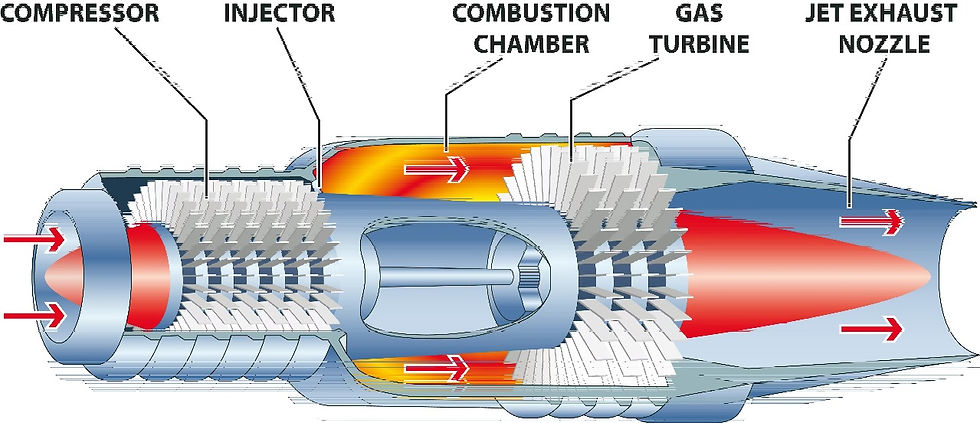The Beginner's Guide to Aerospace Engineering
- Krish Pesswani
- Jan 1, 2025
- 4 min read
Updated: Apr 5
Aerospace engineering isn't just about reaching new heights—it is about redefining what is possible in the boundless expanse of air and space. It's an intriguing field that combines creativity, science, and advanced technology to design and build airplanes, rockets, satellites, and even spacecraft exploring distant planets and galaxies.
So, let's begin with four fundamental concepts of aerospace engineering: aerodynamics, propulsion systems, structural analysis, and control systems.
Aerodynamics
In simple words, aerodynamics is the study of air flowing around objects, particularly vehicles such as cars, airplanes, and rockets. If you're an F1 fan, I am pretty sure you have heard of making the car more aerodynamic. This essentially means optimizing the design to minimize drag on an object when it's in motion; what's drag, you may ask? It is the resistant force opposing an object's motion through the air. This slows down the speed of the object. Drag has many limitations; vehicles and aircraft must expend more energy to overcome these drag forces, leading to higher fuel consumption. In aerospace applications, the need to counteract drag may require additional propulsion systems, reducing payload capacity, such as the number of passengers and cargo, which are essential for astronauts conducting space exploration missions. Drag may also cause an irregular and chaotic flow of air, known as turbulence.
Lift force is the upward force that allows an aircraft to rise and remain airborn. It is created by the shape and angle of the wings as they move through the air, balancing the pull of gravity. Lift force can act in either a positive or negative direction. Positive lift helps a vehicle move upward, as seen in an airplane gaining altitude. Conversely, negative lift, also known as downforce, is observed when an airplane attempts to lose altitude. Downforce is also commonly used in Formula 1 cars to enhance traction by increasing the force of the vehicle's contact with the track, making it more stable for the driver. Lift in an airplane is generated from a specific type of wing design known as the Airfoil shape. We will dig deeper into that in our next blog.
Propulsion System

Moving on, the propulsion system - this is the system that generates thrust to move an aircraft or spacecraft. There are many types of propulsion systems; the two main ones are jet propulsion and rocket propulsion. Jet propulsion systems are used in airplanes, where the thrust is usually generated by applying Newton's third law: for every action (force) in nature, there is an equal and opposite reaction. In this case, air intake and combustion create an equal and opposite reaction (thrust). The accompanying diagram illustrates the key components of a jet propulsion system. Rocket engines are used on most space launches. The most common type of rocket engine is the chemical rocket, where fuel is ignited to produce hot gases expelled to generate thrust. There are many other types of engines within the jet and rocket propulsion system, but that's a topic for later.
Structural Analysis
Next comes the structural analysis, which is considered the most critical part of an airplane or spacecraft. It studies how materials respond to forces like tension, compression, shear, etc. The first step is to consider the mission objective, whether we are constructing a spacecraft for a short trip to a satellite or a long journey to explore Mars. The subsequent step involves defining the geometric configuration of the structure. This includes determining the aerodynamic and structural configuration, such as the shape of the wings or the body of the rocket, which must integrate structural and aerodynamic considerations. Following is the selection of materials made by the engineers. Materials are decided based on strength, weight, thermal resistance, fatigue resistance, and many other things. A few commonly used materials are aluminium alloy, which is lightweight; titanium, which is resistant to high temperature; and carbon fiber, which is both strong and light. After determining the basic configuration of the spacecraft, engineers use computational techniques that break down the structure into more minor elements to evaluate stresses, strains, and deformations under various conditions. This provides a predictive framework for structural performance under operational loads and during flight phases such as launching or landing. Using the result from the structural analysis, engineers refine the design, and once the design is optimized, prototypes are created for rigorous testing: structural tests, vibration tests, and environmental tests.
In conclusion, the structural analysis has four key considerations: safety, efficiency, manufacturability, and lifecycle.
Control Systems
Control systems encompass a combination of hardware, like actuators and sensors, and software algorithms that work together to monitor and adjust the flight dynamics of an aerospace vehicle. Its primary purpose is to have an accurate navigation system and guidance, such as communication, and automate particular tasks to maximize efficiency and safety.

The first key component is the actuator and control surface. An actuator is a mechanical or electromechanical device that moves control surfaces based on the inputs from the control system. Types of actuators consist of Hydraulic actuators and Electric actuators. Examples of control surfaces are Flaps and Slats (Adjust lift and drag for specific flight phases), Elevators (control the up and down movement), and Rudders (control the side-to-side movement)
Another key component of the control system is a sensor. Sensors gather real-time data about the vehicle's orientation, speed, altitude, and external conditions. Examples of these are GPS and Pilot tubes (Measures the airspeed ).
The autopilot system is another common key component. It helps maintain altitude and perform course corrections. It also enables smooth transitions between waypoints in navigation without needing a person.
Anyway, that's all for today. Stay tuned for the upcoming blog, which discusses what an Airfoil shape is and how it works.




Can't wait for the next one!